
The Sinaloa crow is a crow native to western Mexico.

The purple heron is a wide-ranging species of wading bird in the heron family, Ardeidae. The scientific name comes from Latin ardea "heron", and purpureus, "coloured purple". It breeds in Africa, central and southern Europe, and southern and eastern Asia. The Western Palearctic populations migrate between breeding and wintering habitats whereas the African and tropical-Asian populations are primarily sedentary, except for occasional dispersive movements.

The piping plover is a small sand-colored, sparrow-sized shorebird that nests and feeds along coastal sand and gravel beaches in North America. The adult has yellow-orange-red legs, a black band across the forehead from eye to eye, and a black stripe running along the breast line. This chest band is usually thicker in males during the breeding season, and it is the only reliable way to tell the sexes apart. The bird is difficult to see when it is standing still, as it blends well with open, sandy beach habitats. It typically runs in short, quick spurts and then stops.

Cassin's finch is a bird in the finch family, Fringillidae. This species and the other "American rosefinches" are placed in the genus Haemorhous.

The lark sparrow is a fairly large New World sparrow. It is the only member of the genus Chondestes.
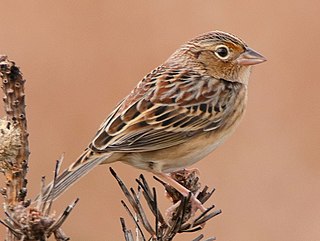
The grasshopper sparrow is a small New World sparrow. It belongs to the genus Ammodramus, which contains three species that inhabit grasslands and prairies. Although sometimes found in crop fields and they will readily colonize reclaimed grassland. In the core of their range, grasshopper sparrows are dependent upon large areas of grassland where they avoid trees and shrubs. They seek out heterogenous patches of prairie that contain clumps of dead grass or other vegetation where they conceal their nest, and also contain barer ground where they forage for insects, spiders, and seeds. Grasshopper sparrows are unusual among New World sparrows in that they sing two distinct song types, the prevalence of which varies with nesting cycle. The primary male song, a high trill preceded by a stereotyped series of short chips, is reminiscent of the sounds of grasshoppers and is the origin of this species' name. Like some other birds of the central North American grasslands, this species also moves around a lot, not only via annual migrations, but individuals frequently disperse between breeding attempts or breeding seasons. Grasshopper sparrows are in steep decline across their range, even in the core of the breeding distribution in the tallgrass prairies of the central Great Plains. The Florida grasshopper sparrow is highly endangered.
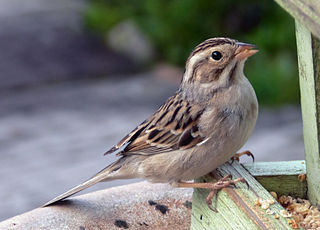
The clay-colored sparrow or clay-coloured sparrow is a small New World sparrow of North America.
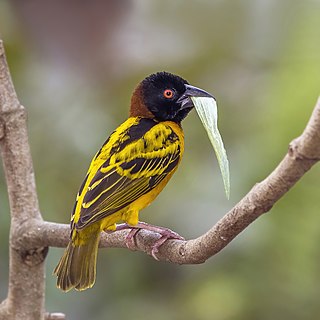
The village weaver , also known as the spotted-backed weaver or black-headed weaver, is a species of bird in the family Ploceidae found in much of sub-Saharan Africa. It has also been introduced to Portugal and Venezuela as well as to the islands of Hispaniola, Martinique, Puerto Rico, Mauritius and Réunion.

The white tern or common white tern is a small seabird found across the tropical oceans of the world. It is sometimes known as the fairy tern, although this name is potentially confusing as it is also the common name of Sternula nereis. Other names for the species include angel tern and white noddy in English, and manu-o-Kū in Hawaiian. The little white tern, previously considered a subspecies of the white tern, is now recognised as a separate species.

Brewer's sparrow is a small, slim species of American sparrow in the family Passerellidae. This bird was named after the ornithologist Thomas Mayo Brewer.

The Caribbean martin or white-bellied martin is a large swallow.
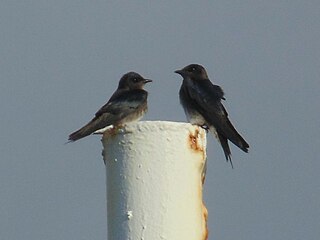
The Cuban martin is a large swallow endemic to Cuba.
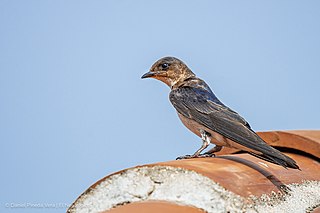
The grey-breasted martin is a large swallow from Central and South America.
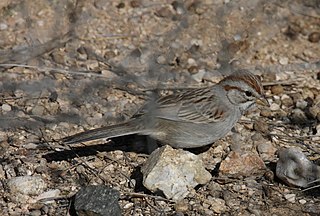
The rufous-winged sparrow is a medium-small, long-tailed New World sparrow with a gray face and rusty crown and supercilium; the rufous lesser coverts of the wing for which it is named are often concealed.
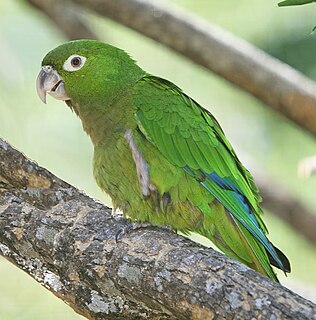
The olive-throated parakeet, also known as the olive-throated conure in aviculture, is a species of parrot in the family Psittacidae. It is found in forest and woodland in Jamaica, Mexico and Central America, and has been introduced to Hispaniola, in the Dominican Republic.

The Cuban green woodpecker is a species of woodpecker in the family Picidae and tribe Melanerpini, known locally in Cuban Spanish as carpintero verde. It is the only species within the genus Xiphidiopicus and is one of two woodpeckers endemic to Cuba. It is the most widespread and common woodpecker in Cuba, inhabiting primarily woodlands, as well as dry and wet forests, pine forests and mangroves. The population of the Cuban green woodpecker is stable and its status is listed as "Least Concern".

The Cuban oriole is a species of songbird in the family Icteridae. It is endemic to Cuba.

The purple martin is a passerine bird in the swallow family Hirundinidae. It is the largest swallow in North America. Despite its name, the purple martin is not truly purple. The dark blackish-blue feathers have an iridescent sheen caused by the refraction of incident light giving them a bright blue to navy blue or deep purple appearance. In some light they may even appear green in color.
Bourne's heron, also known as the Cape Verde heron, Cape Verde purple heron or Santiago heron, or locally in Portuguese as the garça vermelha, is an endangered subspecies of the purple heron that is endemic to the Cape Verde archipelago, in the Atlantic Ocean off the coast of West Africa. It is sometimes considered a full species, Ardea bournei.
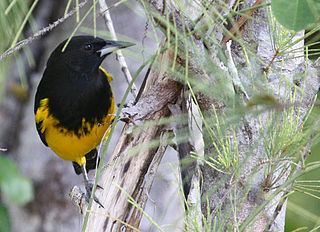
The Bahama oriole is a species of songbird in the New World blackbird family - Icteridae. It is endemic to the Bahamas. It is listed as endangered by the IUCN (CR). The taxon was originally classified as its own distinct species in 1890 by Joel Asaph Allen before it was lumped with the Cuban oriole, Hispaniolan oriole, and Puerto Rican oriole into a single species by the ornithologist James Bond in his book "Birds of the West Indies". It wasn't until 2010 that all four birds were again elevated to full species status based on a combination of evidence from DNA, plumage and song. Since it was not recognized as a distinct species for so long, the Bahama oriole's preferred non-breeding season habitat is unknown and current estimates of its exact numbers remain vague.




















